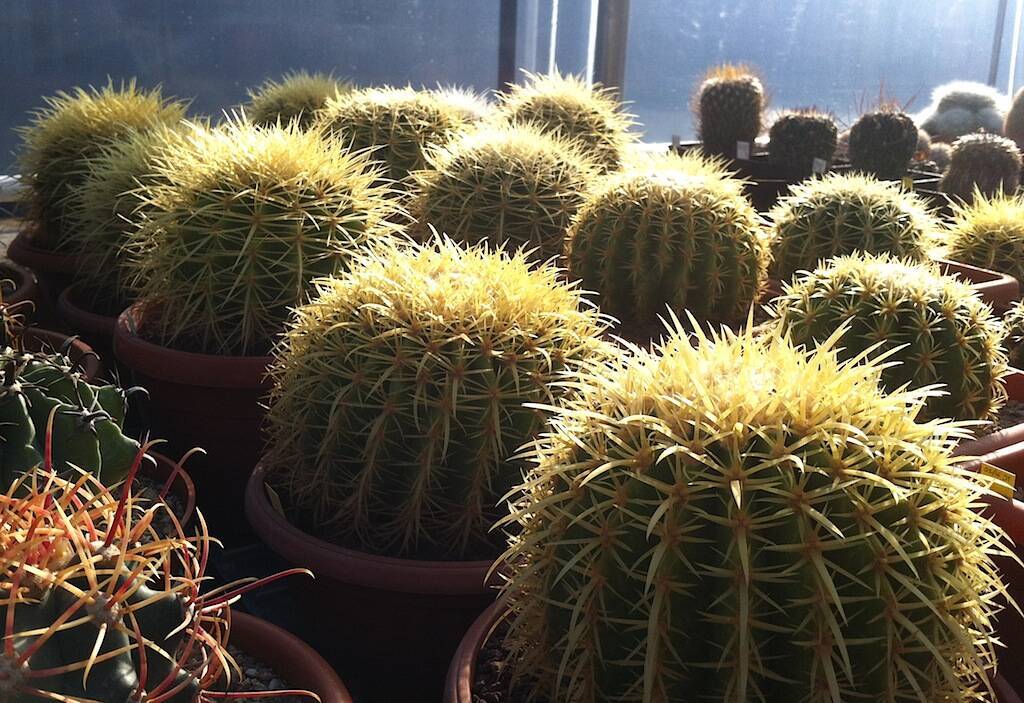Repotting is often one of the reasons why many people steer clear of cacti. Maybe they like the plant, but the idea that sooner or later it has to be repotted, with all those thorns, frightens those who are new to this kind of plant. Many people even decide to give up on cacti for getting leafy succulents, which are much easier to deal with when repotting. In fact, even particularly prickly plants like Echinocactus grusonii or Ferocactus are not so complicated to repot. A little experience and a few “tricks”, and you can get out of it without literally having to “give blood”.
Let’s see how to proceed and all there is to know about repotting,
especially the most challenging ones due to the plant’s size and the thorns on the stem. (…)
There is repotting and repotting…
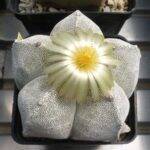
Obviously, repotting is easy for Cactaceae or succulent plants with little or no thorns, such as most Astrophytum, but also Matucana madisoniorum, many Gymnocalycium, some Turbinicarpus, Frailea, as well as plants with papery thorns (Tephrocactus articulatus v. papyracanthus) or silky-thorns, such as some Mammillaria and Rebutia, or succulents such as Echeveria, Crassula, Lithops, etc… In the same way, everything is easier if you are dealing with young specimens and therefore of small dimensions. In these cases, even the most prickly plants can be repotted without problems since the plant itself weighs very little, and it is not necessary to exert pressure or special efforts to remove it from the pot and place it in a new container.
Challenging repotting
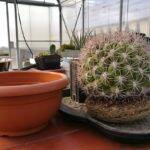
For more demanding subjects, such as a E. grusonii from 20 centimetres in diameter upwards, it is necessary to be patient and take some precautions. Many people use gardening gloves: I avoid them because they deprive the hands of the slightest sensitivity, and it is easy to break thorns or damage the plant if you don’t have the right… touch. When starting a repot of this kind, i.e. large plants covered in thorns, the first thing to do is to have the necessary supplies on hand, i.e. the new pot and the potting soil. At that point, it will be enough to wrap the plant in an old towel or fix some polystyrene blocks to the thorns to protect them and avoid breaking them or getting pricked. When the plant is “packed”, it can be lifted and tilted to the side so that the old pot can be removed.
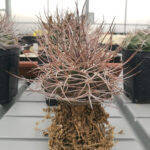
If the plant has been in the old container for many years and the soil is compact, the operation could be more complex. In the case of a plastic pot, you will have to vigorously beat the walls of the container with the palm of your hands (in many cases, you need your fist!) to try to make the soil loaf come off and slide the plant out. If you have used a terracotta pot and the plant has not been repotted for years, you may need to arm yourself with a hammer to break the old container. With terracotta pots (porous material, unlike plastic, which is perfectly smooth), the roots stick to the inner walls because they can absorb water, and in many cases, during the repotting, there’s no alternative to breaking the old container.
In this regard, it must be said that even the choice of the correct pot is fundamental, and on every type of container, there are pros and cons. Terracotta or plastic? Round pots or square pots? Small vases or wide bowls? Many individual vases or more plants in one container? All of these questions are answered, as well as fully explored, in this article.
On repotting, in general, you can find everything at this other link.
Once the plant has been freed from the old pot, it is advisable to check the state of the roots, verify that there are no parasites such as cochineal and remove as much as possible the old soil. If the plant is already in suitable potting soil, it will be enough to shake it and free the roots a bit; if the old substrate is rich in peat or too much used, it’s better to get busy (maybe even with the help of a brush) to remove it and free the root system.
If some roots are too long, and if they’re not primary roots (thick and fleshy), you can shorten them with scissors or gardening nippers: just a clean-cut, the plant has no problems, stimulated to produce new capillaries.
New pot, new soil
Before repotting, many people recommend leaving the plant’s roots in the air for a few days to allow them to heal the wounds suffered during cleaning. Frankly, I see the reason only if some primary ones are broken, or the root system has been thoroughly cleaned, for example, because the roots were dry or rotten. In other cases, I repot immediately after cleaning, with the only care to use dry soil and not to water for at least ten days after repotting.
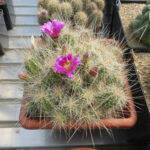
Whichever choice you made (wait a few days or repot immediately), all you need to do is to put a little potting soil in the new pot, place the plant on it, being sure the collar is at the right height related to the edge of the container and fill it all around the stem with the new substrate. Some growers recommend putting expanded clay, pumice, or coarse-grained lapilli in the bottom of the pot to promote drainage. I do this only when I use very profound vases compared to the size of the root system or when the roots are few, dry or too short: in all other cases, I see no reason to deprive the plant of soil if it’s already draining and rightly formulated.
Here I have written about the various types of substrate I use.
With small plants, easy to handle, it is better still to hold the plant with one hand, place it at the right height related to the edge of the pot, leaving the roots in mid-air, and fill the pot with potting soil with the help of a shovel. At the end of this operation, it is a good idea to lightly tap the edges of the new container with your hands, then lift and drop the pot several times on the table to let the potting soil settle and not leave empty areas inside the container.
A little trick
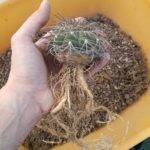
More than strongly thorny plants – Ferocactus, for example, can be easily handled by lifting them by the old thorns, as they are so strong – in my opinion, the real problem is plants with fragile or hooked thorns. In the first case, you need a lot of attention and a good dose of experience (and patience) to avoid breaking the thorns; in the second case, you need a lot of attention because the hooked thorns (as in the genus Ancistrocactus) will inevitably get stuck to the skin with the risk of making it difficult to clean or move the plant while filling the new pot with soil. A trick with this type of plant is to flush and clean the plant, place two sticks (or two brushes that are not too large) on either side of the new pot, place the plant between the two sticks, holding it by the spines and letting the roots fall free into it. When the plant rests on the two supports, we will have our hands free to fill the pot with soil, and when we arrive at the right level, we just have to take out the sticks, hold the plant by the thorns and finish the job by putting the substrate around the collar.
Beware of glochids!
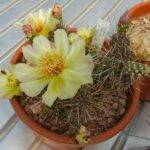
The really tricky plants are those of the Opuntia genus. Most of them have very short and thin thorns, called glochids, that can enter the skin and firmly hook thanks to the hooked tip. Glochids don’t hurt, but they are very annoying, irritating and almost impossible to remove immediately. For repotting these plants is the only time I use gloves unless the Opuntia “blades” are large and the glochids are widely spaced, in which case you can handle the plant without getting glochids on your fingers.
SUBSCRIBE TO THE SITE – If you liked this article, subscribe to the site to have access to all the contents for one year or three months depending on the formula you choose. Here you will find terms and conditions.
SUBSCRIBE TO THE NEWSLETTER – If you want to receive the free newsletter every time new content is published (even if you have not subscribed to the site), fill in the fields at this link!
Correlated articles
Six identical cacti in three different soils
How to repot cacti and succulent plants
Substrates for cacti and succulents
The correct soil: the materials you can use
© The texts, videos, photos and graphic elaborations of the site “Il fiore tra le spine” are original material and are covered by copyright. It’s forbidden to reproduce them in any way.


